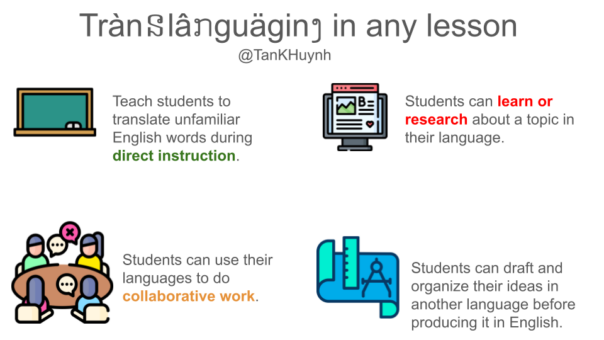Translanguaging Can Be Part of Any Lesson
A MiddleWeb Blog
 Translanguaging is the use of a person’s entire linguistic toolbox. This means a person uses any and all of their languages to understand and to communicate.
Translanguaging is the use of a person’s entire linguistic toolbox. This means a person uses any and all of their languages to understand and to communicate.
Translanguaging stands in stark contrast to English-only policies. Multilingual learners (MLs) can boost their academic achievement when they “translanguage” because they are free to use more tools to learn and engage.
As schools move away from English-only policies and create classrooms that are linguistically inclusive, translanguaging helps us shift our instruction for MLs.
Fortunately, educators do not have to be English as an Additional Language (EAL) specialists to incorporate translanguaging in their lessons. Teachers do not even have to know students’ languages in order to create a translanguaging classroom. Here are some strategies we can use.
Translanguage in presentation slides
Many teachers create presentations to visually scaffold a lesson for MLs. They can translanguage in their presentation by translating key words used in the unit.
For example, a social studies teacher can translate the words society, political, economic, religious, and military as key words when students are preparing a report that analyzes the impact of the Industrial Revolution.
When teachers provide specific examples in the lesson, they can show students translated versions of key words so students can better understand the examples. Translanguaging in this way helps students more successfully engage with the report now that they know, for example, what political or society translates to in their own languages.
Translanguaging while researching
When students are assigned a research project, they often search English sources. Unfortunately, these sources are often incomprehensible to them. However, if they read about the same topic in their heritage language, they are more able to understand the information and collect relevant details.
They can even write notes in another language as they research. Teachers do not have to feel that they need to understand students’ resources in another language. During conferences, teachers can access students’ research by having conversations about the information students have gathered.
Translanguaging in teams
Oftentimes, learning experiences will require students to work in pairs or small groups. If teammates share a common language other than English, students can work in that language. For example, in a hypothetical group of four students, one student speaks Spanish, another speaks German, and two speak Mandarin.
They will all be using English as the common language, but the two Mandarin speakers might pop in and out of Mandarin as a tool to help them engage in the task and collaborate more effectively. They might brainstorm in Mandarin and then share their idea in English to their other teammates. Collaborating through multiple languages makes teamwork more successful.
Translanguaging the product
It is appropriate to expect that students will be submitting their final product in English, but this does not mean that their work leading towards the summative has to be in one language.
For example, if students are designing an art piece for art class, they can use their languages when interviewing living artists, annotating art pieces, drafting ideas, outlining their thoughts, and conferencing with classmates for feedback. The written reflections will most likely be in English, but translanguaging throughout the process makes producing the final product more successful.
Conclusion
The examples above form the top of a pyramid of opportunities for translanguaging. Students’ languages are one of the most effective tools for academic achievement. By creating space for heritage languages, we can erect scaffolds and bridges that help students understand content and more fully express themselves.
If our schools are to embody global awareness and international mindedness, then our institutions must also be a safe place for all languages to thrive.






























It is an interesting topic. I would like to know more about it. I would like to know more about how to carry out translanguaging class. Will it be suitable to try it in countries like China, where population is not that diversified?